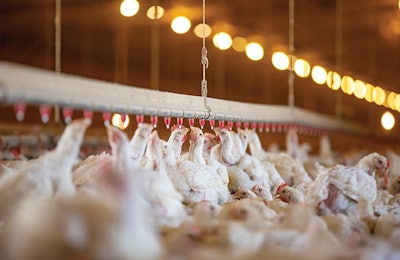
Emerging technology can help broiler producers improve animal welfare outcomes both on the farm and during processing.
As part of the Delmarva Chicken Association's virtual National Meeting on Poultry Health and Live Production, Dr. Karen Christensen, senior director of animal welfare at Tyson Foods Inc. spoke about how technology will move the needle on welfare. Christensen spoke on September 30, 2020.

Karen Christensen, Tyson Foods (Courtesy Tyson Foods)
Measurable broiler welfare outcomes
Christensen stressed the importance of establishing measurable welfare outcomes to gauge animal welfare. Those outcomes focus on the key indicators of health and welfare that can be observed, counted or monitored, and managed for the continuous improvement of welfare.
Some welfare schemes are based on what she called welfare inputs, or the changes in the growing system or requirements that are not related directly to the welfare outcomes. She gave metrics like stocking density requirements or breed requirements as examples. Christensen said these changes in welfare inputs do not necessarily guarantee an improvement in the welfare outcomes.
Setting welfare requirements based on inputs is not the best course of action. Input changes can negatively impact environmental sustainability, and profitability, of commercial production. It also sends a potentially false message to consumers and producers that if inputs are controlled then welfare outcomes will be positive.
In actuality, Christensen said, continuous improvement in measurable welfare outcomes will result in better welfare for broiler chickens. Examples of measurable welfare outcomes are:
On the farm: paw scores, hock lesions, gait scores and leg culls
Transportation and handling: dead on arrivals, damaged wings, bruised legs
Processing outcomes: Unloading procedures, shackling efficiency and stunning efficiency
How technology can help
Christensen said the development of welfare-oriented technology could play a large role in advancing the industry’s ability to assess animal welfare outcomes. Both established and startup companies are developing technology to automatically measure welfare outcomes. This will assist poultry growers and integrators with continuous improvement in animal welfare.
On the farm, there is a growing adoption of video monitoring for bird catching. It allows for review of those practices and coaching for better performance.
In the plant, processing equipment companies are already developing technologies to grade and score paws and to score wings, legs and stunning at processing. She sees a great area of opportunity for visioning technologies to score paw and wing health and potentially assess stunning.
The SMART broiler project
Other initiatives exist to accelerate the development of welfare monitoring technologies on farm. She highlighted the SMART Broiler Project, a collaborative effort founded by the Foundation for Food and Agriculture Research and others, which is working to advance technologies using sensors to automate monitoring, analyzation and reporting of conditions inside the broiler house. Tyson is trialing a number of these technologies to grade their effectiveness and feasibility for their growers.

Welfare-oriented technology could help advance the industry’s ability to assess animal welfare outcomes. (kornnphoto | iStock.com)
She highlighted two promising technologies from the SMART program:
Optiflock: This is a vision-based project which uses cameras to understand flock movement and what it means for welfare outcomes like footpad dermatitis, hock burn, lameness and disease. The concept displays movement charts to demonstrate whether movement is normal or requiring further attention from the grower.
AudioT: This is an audio-based project using microphones to capture bird vocalizations to predict welfare outcomes and generate alerts for the growers.
These technologies, she said, are promising because they allow farmers to see things they couldn’t before in order to make better decisions and they enable measurement of welfare outcomes.

















